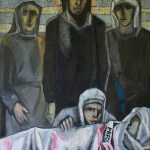
Author: kelise soixante-douze
‘Wonderland’ ran simultaneously in two galleries: Chagall Artists House and Grand Art New Gallery of Contemporary Art, both in Haifa, Israel. I saw the exhibition in Haifa Chagall Artists House non 28 September 2012, which comprised of sculpture, photography, multi-media/2-D works, paintings and several film/videos.

Research visit to learn more about ‘documentary tactics’ of Palestinian artists

Click link for Wonderland – Exhibition slide show
I went to this exhibition in particular in order to do more research related to the article ‘No Occupation Without Representation‘ by HG Masters of Asia Times, that Palestinian artists in particular follow certain ‘documentary tactics’ in their artwork. It seems anyone involved or interested in the area must engage in
“… debates played out by politicians and activists, Israeli and Palestinian, on the international level for their respective strategic interests, as well as in the media, in proxy wars of propaganda and disinformation by factions competing to write the historical narrative of post-Mandate Palestine.
As storytellers and emissaries of Palestinian culture, Palestinian artists across disciplines have been caught up in or have willingly participated in this struggle, as they address the urgent subjects of modern Palestinian culture: dispossession, nostalgia, exile and resistance.”
– from the article by HG Master in Art Asia Pacific
Art and Conflict
In light of the article I had just read, I was particularly moved by the film “Sho Q’ostak? [What’s your story?]“ by Israeli-Arab filmmaker Jamal Khalaile. In the film, Khalaile interviews 5 Israelis, who discuss personal narrative as they seek to confirm their identity through history and personal experience – as Israeli, as Jew.

As mentioned in the synopsis of this film as seen on the Israeli Film Center website,
The central issue becomes admitting the Other without having to giving up one’s own identity.
Another interesting film is the 17-minute so-called “mock-mentary” by Yoav Gershon, entitled “Eight-hour Shift”. The filmmaker and once-soldier in the IDF visits former duty stations in order to restage situations he experienced when he served in the military. When I spoke to him later about the film, he said, “I was trying to say that the military makes you numb. It makes your judgement wrong. Even if you are a good person, you are in an impossible situation and environment.” He continues to explain, “”…people say how brutal the Israeli soldiers are, and I wanted to make a statement that explains how a 19 year-old child becomes that way.”

Another favourite piece by Nasrin Abu Bakir makes quite a statement. There are (were) factories in Gaza that make (made) blue jeans. Nowadays, Gaza suffers economic, social and political crises and much of the distress is in large part due to the large wall surrounding the Gaza Strip, which prevents tens of thousands of people reaching work, farm and families on the other side. “The Wall” very directly describes this reality.

This photograph by Abir Athalh is particularly striking and beautiful. Though I was unable to find more information about the artist or the work, to my reading, it speaks of a Palestinian woman’s struggle against oppression, and how she takes up the mantle of resistance – perhaps as more of a sacrifice than a desire to do so, but necessary nonetheless.

This work by an unknown artist looks to be a map of sorts, on skin or leather, suggesting a notion of frailty of maps, particularly in Israel and Palestine. (If you know who is the artist, then by all means, please leave a comment below!)

Participating artists: Abed Abdi, Nasrin Abu Baker, Tal Adler, Raida Adon, Noa Arad-Yairi, Abir Athalh, Asad Azi, Durar Bacri, David Behar-Perahia, Eliahou Eric Bokobza, Yuda Brauen, Guy David Briler, Yoav Gershon, Shuka Glotman, Michael Halak, Ruba Hamdan, Raafat Hattab, Hoda Jammal, Jamal Khalaile, Micha Kirshner, Beny Kori, Igor Kruter, Ilya Medvedev, Narine Melikyan, Buthina Millhem, Dvora Morag, Gilad Ophir, Noam Rabinovitz, Israel Rabinovitz, Hadas Reshef, Merav Sudaey, LinadaTaha, David Tartakover, Yuval Yairi, and Osama Zaatar.
More Information
- Website/press release with more information about Wonderland – Political Conflict in Art (English)
- Download the PDF version of the press release for Wonderland exhibition: wonderland-invitation.pdf (English, German, Arabic, Hebrew)
- Blog information about Wonderland exhibition by artist Hada Reshef (Hebrew)
- Project paper ‘Art and Politics – Looking for Critical Distance in the Holy Land‘ by Kelise Franclemont (2013)

Exhibition details: “Wonderland – Israeli and Palestinian Artists – Political Conflict in Art” in Chagall Artists House, Haifa, Israel runs from 12 Sept 2012 through February 2013. Curated by Shirley Meshulam and produced by Yossi Ben-Bassat.
A second run of “Wonderland” appears in Bundestag, Berlin from January 2013.




















